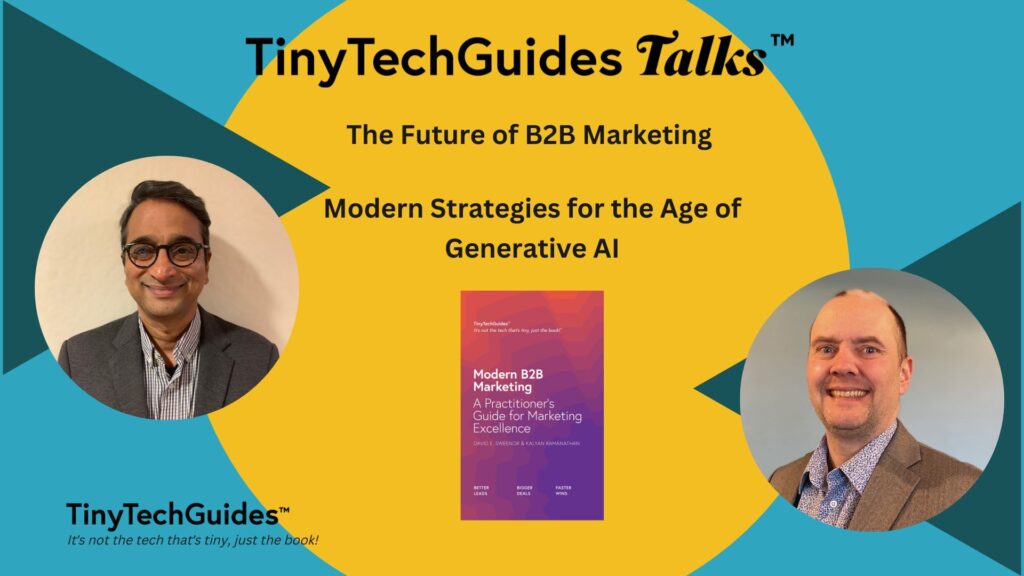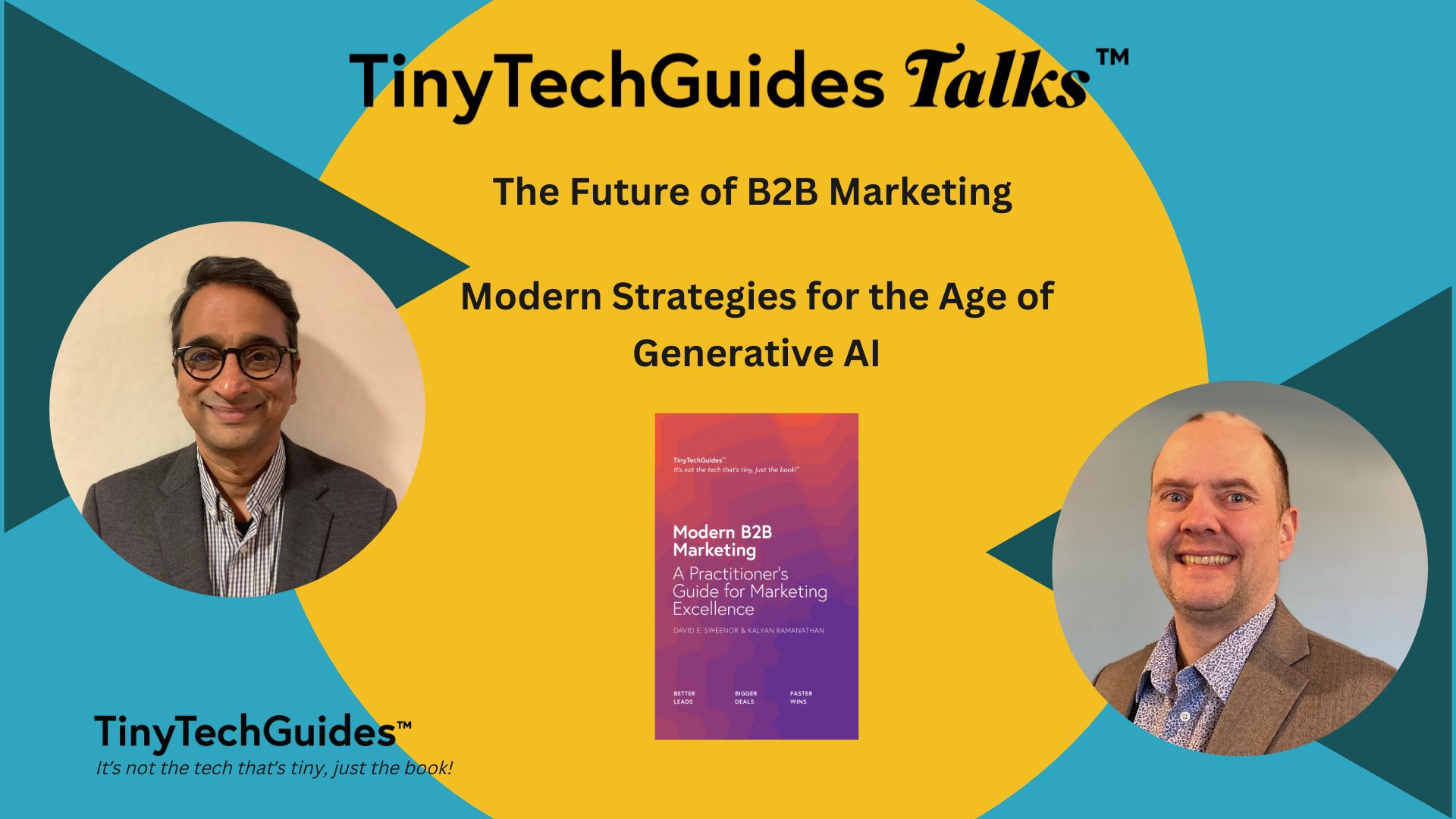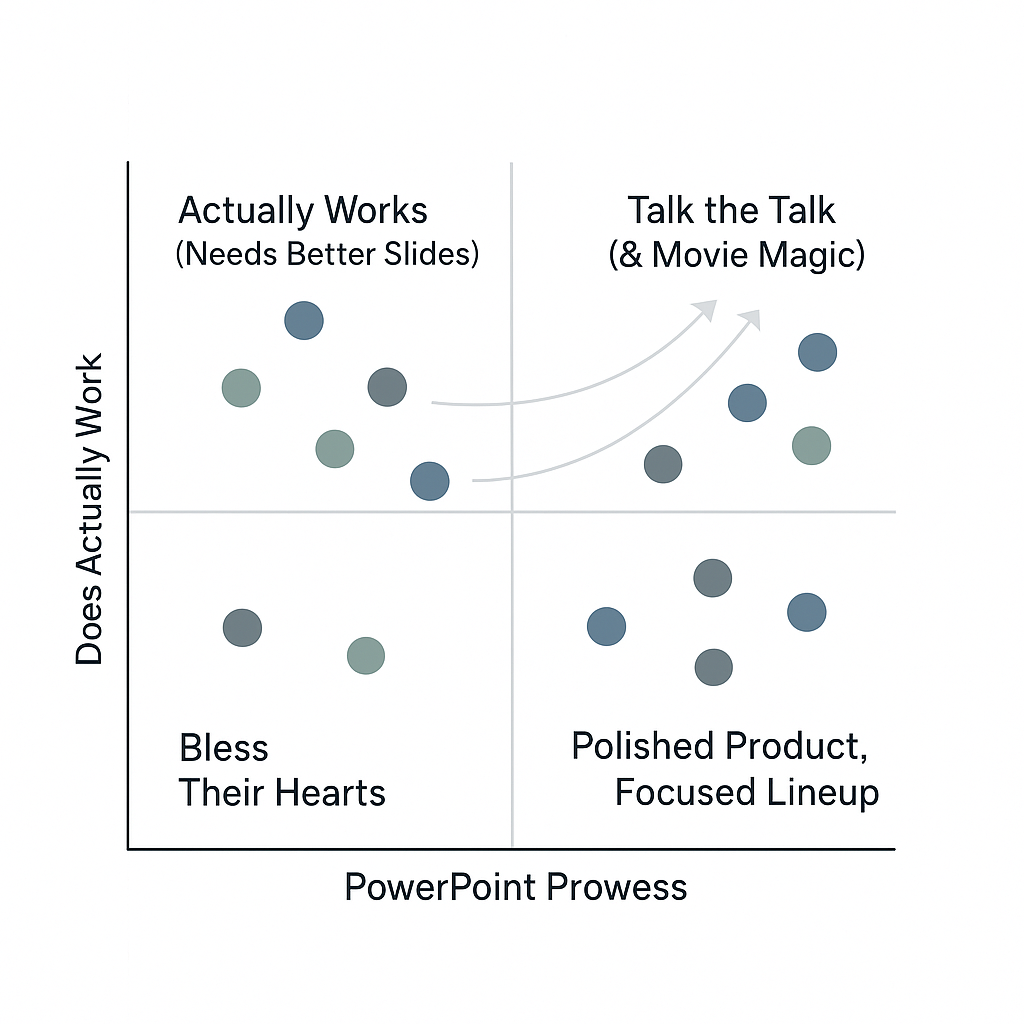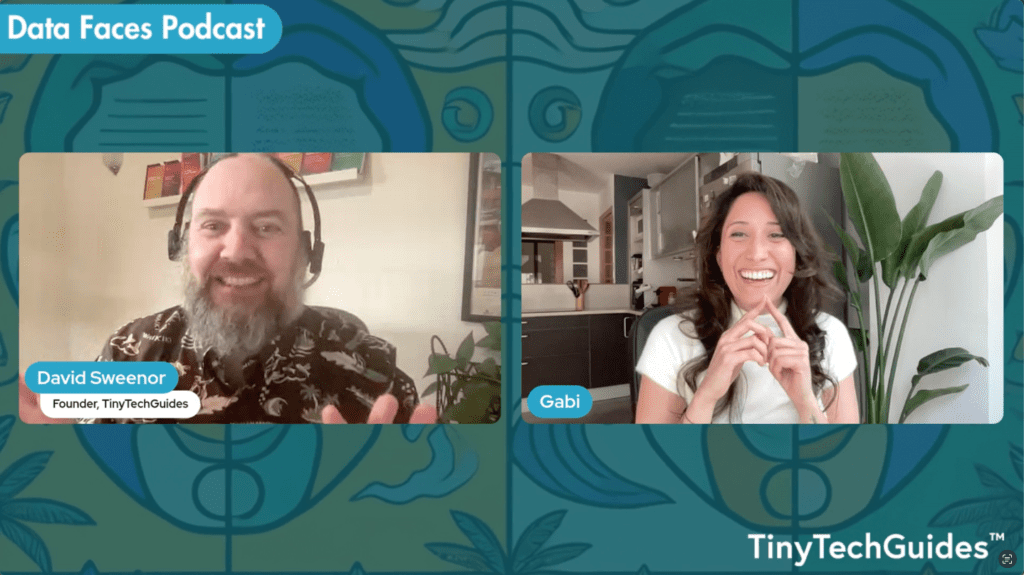The Future of B2B Marketing
Modern Strategies for the Age of Generative AI

Need a copy? You can get one here.
An interview with author Kalyan Ramanathan
In this episode of TinyTechGuides Talks, I was fortunate to have the opportunity to interview Kalyan Ramanathan, a modern-day marketer and author of Modern B2B Marketing. You can watch the full episode on YouTube.
Transcript
Note: this has been edited for clarity.
David Sweenor
Good morning, good afternoon, and good evening. Welcome to TinyTechGuides Talks, The Future of B2B Marketing: Modern Strategies for the Age of Generative AI. I’m super excited to welcome Kalyan Ramanathan, author of Modern B2B Marketing: A Practitioners Guide for Marketing Excellence, to the show.
Kalyan Ramanathan
Thank you, David. Happy to be here.
David Sweenor
Well, Kalyan, we have five questions that we’re going to ask you, and then we’ll ask you three fun bonus questions at the end. But let’s just start with your origin story. How did you get to where you are today? Your background is not in marketing. I looked at LinkedIn; I think you were an engineer by trade.
Kalyan Ramanathan
That’s exactly right. David, I started my career many, many, many moons ago, as an engineer by education, I should say. And while I was an engineer, I used to work in chip design, working on tiny, tiny, tiny little things. I always used to look at the marketing guys on the other side of the office way. I would always say, man, they are having parties; they’re having fun. And someday, I want to be a marketing guy. I had a manager who once told me, “Look, vision without action is daydreaming. And action without vision is a nightmare.” So he said, “If you want to do something, go for it.” And so, I ended up getting an MBA, and then I moved over to the dark side. I’ve been in marketing for over 20 years and have seen every aspect of marketing. From the traditional, let’s get on the phone, call a prospect, and try to convert them into a customer, to digital marketing, which is all in vogue right now. So that’s been the journey. It’s been 20 long years of living through the slog of marketing and learning it from the pit.
David Sweenor
Yeah, that’s amazing. It’s interesting that we both started out in semiconductors. You were on the design side, and I was doing data analytics for semiconductors. So I find that a little serendipitous. So, to your book, why did you write Modern B2B Marketing?
Kalyan Ramanathan
Yeah, in some sense, it’s a pay-it-forward book, right? When I was in business school for my MBA many moons ago, they taught a lot of theory of marketing. In particular, the four P’s and how to think about getting someone to be excited about your product. There was a lot of theory which I think over time, as I’ve learned, doesn’t quite stand the test of time. I mean, the frameworks have changed quite a bit. The strategy, and the tactics, and the KPIs of marketing are so different now compared to what it was many years ago. And so what I wanted to do, in this case David, working with you, was to write a very practical book where you talk about, what are the key KPIs that a marketing team should care about? How should they execute the marketing function? What strategies make sense today? Given that there are so many more channels to engage with prospects and customers. Finally, what I’ve also realized is that the marketing team is, in some sense, a merry band of people, right? I mean, many people with many different skills, and so, in some sense, you need to rewrite what marketing is all about. That was what we tried to address with this book, a very practical way to think about marketing, the teams that are in marketing, and how they all come together to indeed make marketing successful within an organization.
David Sweenor
Yeah, I think that’s the one thing I really enjoy about the book, Kalyan; we worked really hard to bring in that real-world experience that we’ve had. I think what we opened the book up with, I don’t know how many years it was, but it was like 15 companies. So that is a lot of experience for people to know what is it like, out there in the trenches. To that point, you’ve consulted with a large number of B2B startups in Silicon Valley. What’s the number one question you get? When do startups get marketing right or perhaps wrong?
Kalyan Ramanathan
Yeah, it’s a great question. I’ve talked to many CEOs early in their company journey and sometimes marketing journey. The question that I always get from the company is, what is most important? Is brand more important? Is messaging more important? What about demand-gen and campaigns? There’s a lot of internal debates. Sometimes chaos comes from people outside of marketing, in particular, trying to understand, what is important in marketing. I always tell these companies that the first and perhaps the most important goal of marketing is really about generating revenue for the company, right? It’s all about, being highly aligned with the go-to-market team and generating revenue (ARR), and in particular, pipeline for the company. Honestly, if you’re not generating a pipeline for a company, and if that pipeline doesn’t convert into revenue, what comes out of the marketing team is worth nothing. Because frankly, your company itself may not be in business tomorrow. So, let’s not lose sight of what is most important from a marketing KPI point of view, which is, pipeline–the number one and the most important goal and that’s the reason why, David. When people ask me what are you, I always say I’m a revenue-focused marketeer. I can do thought leadership, I can do messaging, I can do AR and PR, I can help out in campaigns, you name it. But at the end of the day, my number one KPI and the number one KPI is just wanting everybody in marketing to be around that most important goal, which is revenue and pipeline. So frankly, if you don’t have that, you might as well pack your bags and go home.
David Sweenor
Yeah, I get that question a lot as well in my consulting world. They’re like, how do you measure the value of a PMM team? We’ve talked at length about this Kalyan; it’s like a glue function. And I say, well, you can talk about are you ready? How prepared are you? But I say the same thing, it comes down to pipeline and revenue. If you don’t have any money, you’re going home.
Kalyan Ramanathan
Yeah. The good thing David, is that it is a good measure that I also think applies, up and down. It applies to just about everybody on the marketing team. It’s a good glue to make sure that we are all focused on the eye on the prize, which is, helping sales sell more and helping the company succeed. That helps make marketing very strategic within an organization.
David Sweenor
Yeah, absolutely. And so I’m going to be the first to mention this Kalyan, generative AI. It’s hugely popular out there. What’s your perspective on how the marketing function will evolve? And should I be worried, should marketers be worried about generative AI?
Kalyan Ramanathan
Well, that’s a mic-drop moment, David. I mean, let’s close up the marketing shops and go home. Now look, in all seriousness, generative AI is definitely a game changer for marketing. The agenda in generative AI starts with content. Content is the staple of marketing. Generative AI can create better content, or I should at least say more refined content than, perhaps, many humans can write. So all you have to do is give generative AI a few bullets, and it can write a great blog. You can give it a few details about a customer and a template of what a customer case study looks like, and it can create a customer case study for you in half or one-quarter of the time it might take a human to put it together. Generative AI can also respond to customers and sales emails better than salespeople can, right? So, gone are the days where we’re going to sit down and create laborious sales cadences, right? It can be done much faster and much more efficiently with generative AI. So, generative AI is definitely a game-changer for us. But at the end of the day, it is a tool. And you’ve got to remember that tools need people to drive it. Tools need people to govern. And so, we should not think of generative AI as something anything more than a set of utilities, like many utilities in marketing. These utilities and tools can help us do these baseline tasks and activities in a much more efficient way. It allows us to evolve and focus on bigger tasks and bigger automations,which can now happen in marketing, which couldn’t have happened in the past. Imagine trying to create a customized dashboard, for the type of customer who comes to your website today. That task would have required hundreds of hours and 1000s of dollars to the customer and create and what not, and that can be created by generative AI very quickly now. So again, if you think of it as a tool that can allow you to customize and engage and more creatively and more efficiently deliver experiences to your customer. That’s the ultimate lock that generative AI can provide you.
David Sweenor
Yeah, it certainly can do things much faster. I just hope companies don’t use it as a a crutch. You need to have a unique perspective on the world. Or else you regress to the mean. You’re saying the same thing that everybody else’s saying. I think people gotta be very weary of that, because I read a lot of blogs and content, I can tell when it’s written by generative AI, and it’s generally uninformative to me. It’s boring. It’s not that exciting to read.
Kalyan Ramanathan
Yeah, you and I have spent a fair amount of time in generative AI, right? At the end of at the end of the day, generative AI does not excuse you from not having a point of view. It does not let you off the hook in terms of having something unique to bring to the market. So, I think you do need that. That human governance and that human input into a generative AI system. And then, you need to differentiate, and that differentiation comes from the way you will look at the market and what you bring to the generative AI system, which will then, obviously, take it and put some nice creative words and images around it.
David Sweenor
Sure, all right, Kalyan, that’s a great response there. The fifth question, is the last one, and then we’re gonna get to the bonus questions. For people who are, perhaps, early in their career or even experienced professionals, what’s the key takeaway you want them to get from this fantastic book that you wrote?
Kalyan Ramanathan
Yeah, look, I will tell you. For people who are looking for a job in marketing, this book does a really good job of explaining the various facets of marketing, right? Marketing is not a monolith function. There are many components that makeup marketing. Everything from comms and AR and PR, to demand gen, to product marketing, to marketing ops and operational marketing. So, marketing is indeed that merry band of many skill sets. If you are someone who is very good at thought leadership and communications-driven, you have a home in marketing. If you are very focused on product messaging and positioning, there is a place for you in marketing. If you are someone who knows how to execute things well, you have a demand-gen function, and that could be a great home for marketing. Or finally, if you’re someone who loves numbers and wants to look at numbers and slice it 10 ways to Sunday and analyze data in many forms, you have a role as a marketing ops person within marketing itself. So marketing provides a home for many different skill sets within that organization itself. But there is a common thread across all of these things, and that’s the buyer journey. The buyer’s journey pulls together all of these elements and helps build a pipeline and revenue for the company. So, what I would like for anyone who was early in their marketing career to take away from this book is that, hey, marketing is a great home that allows you to really hone your skill sets in many different dimensions and ultimately become a very seasoned marketer. So, there’s definitely a lot for anyone who is starting out early in their career within the marketing domain. It truly can allow you to blossom in one particular domain or become a generalist and become someone who is good at many different functions within marketing.
David Sweenor
That’s a good point. I find, to your point, there’s something for everybody. You can be creative or very quantitative, and there’s a role for you….and I don’t ever want to do a pricing project again; I’ll tell you that right now. But, you can look at cannibalization, understand all that. For the more mathematically inclined folks, there are roles out there for you.
Kalyan Ramanathan
Yeah, that’s the beautiful thing about marketing, right David? You don’t get caught beholden to doing just one thing, right? I mean, you’re not just writing code as you might be if you’re an engineer, or you’re not just talking to customers as you might be if you’re in the sales organization. Marketing allows you to try many things. And, hopefully, you’re in a company where you do have that opportunity, spreading your wings and trying out a few things, and then finding out what is the thing that really sings to you and really becoming an expert in that world.
David Sweenor
To your point, how you opened this when you were an engineer and chip designer and you looked at the marketing people having fun. A great thing if you work for the right company, is the events in marketing. It’s like golf. It’s always in a wonderful, usually beautiful location. So the travel is not bad as well.
Kalyan Ramanathan
Yeah, but I do want to caution people who look at marketing as purely glamorous events. Behind all these glamorous roles, there is hard work involved, right? I mean, the people who are setting up those golf events are doing a lot of work to make sure that it is a success. So, there is work involved, without a doubt. There’s a lot of fun and enjoyment, not just in executing some of these things but also seeing a positive outcome out of many of these activities.
David Sweenor
Absolutely. All right, Kalyan, that’s exactly right. Are you ready for the TinyTechGuides Top Three bonus questions?
Kalyan Ramanathan
Holy macaroni David, knowing you, I know these questions are gonna stump me. So I’m as ready as I can ever be.
David Sweenor
All right, the first one, if you could travel back in time and pitch a modern product to someone from the past. What would you pitch them? And how would you explain it to them?
Kalyan Ramanathan
Oh, David. That’s a good question. You know I’m a big Tesla fanboy. I love my Tesla. And I know you don’t have an electric car. And I know there are many people who don’t have electric cars, especially people who live in, you know, anywhere outside the valley bubble, right?
David Sweenor
They’re not suited for the cold Kalyan; they can’t drive on the road that’s iced over.
Kalyan Ramanathan
Yeah, so I would definitely pitch a Tesla to you, man. And the way I would do it is that friends don’t let friends drive non-EV cars anymore. So, a riff on the old friends don’t let friends drive drunk story. But look, at the end of the day, we are living in a world that has climate problems, where fossil fuels are indeed, only aggravating the situation that we already are in right now. And we all have to move to a better and more climate friendly means. And perhaps, I would say, that there’s even a cost-efficient output options when it comes to automobiles. And Tesla, and EV cars of any kind, right? You don’t have to buy a Tesla, you can buy a GM, a Ford, you name it . They’re truly game changers, right? So, these cars are helping us make a significant dent in climate change. We want to leave this world a better place for our kids. And I think driving better cars is definitely a good start. Now, I will say one other good reason for buying a Tesla, David, I’ve always told you, it’s really brought technology to cars, right? I mean, unlike traditional cars where the car hasn’t changed, and the car doesn’t change ever. Every morning when I go to my Tesla, I see yet another update, right? I mean, it’s got some app, it’s got some feed new feature that that the car has now because it’s been updated over the air, and now I have that new gizmo for Halloween, or I have yet another app for Christmas in the car itself. So, in some sense, that the car is almost an evergreen car. I mean, it’s always improving. It’s always getting better. There are always new things to discover and experience in this car. So in some sense, Tesla has almost made a car into an iPhone. I look forward to driving that car and seeing what’s new in the car every time I get into that into that automobile.
David Sweenor
Right. Well, we’ll talk about privacy in a different episode and all the tracking and hacking that’s going on with the cars. But alright, bonus question number two. You just accepted a new job as Chief Marketing Officer, and this company sells invisible socks, what’s your first marketing move?
Kalyan Ramanathan
Wow, holy macaroni. I’ll start out with the usual thing, better content, campaigns, and this and that, and whatever else. But I’ll start with maybe a pricing promotion here. Buy one invisible sock; get two invisible socks free.
David Sweenor
That’s perfect. I love that. I love that.
Kalyan Ramanathan
You know, the end of the day. It’s all funny money, and it’s all funny products in this case. So, you send me funny money. I’ll send you funny products.
David Sweenor
All right. I love it. All right, the last bonus question here. Let’s imagine you’re in the 1980s. Let’s think about dial-up internetand fax machines. If you had to run a marketing campaign, what is your strategy?
Kalyan Ramanathan
Interesting. Look, David, I come back to something that I think we are also mentioned in the book, which is that, campaigns in particular, right? We have a fascination with the latest, greatest thing, right? I mean, we have to do digital campaigns. We’ve have to do campaigns on social media. Hey, TikTok is happening now. We need to do a TikTok campaign. I think it’s very easy to get caught up in the latest buzz. As a CMO, you definitely do have to constantly be up to up to date and up to speed on the new ways of engaging with your customer. But I still believe that, some of the traditional ways of reaching out to a customer, that plain old telephone line. I wish I had one of those plain old telephone lines here with me. Still, I’m speaking from my home office, so I obviously don’t have one, but this one out here, right, that I’m holding in my hand and imagine it being connected to a cable somewhere and to do a phone line somewhere that still has value man, picking up a phone and talking to a prospect or a customer, engaging with people in a real way. Asking them how has that morning been? And, what are the problems that they’re facing in their day-to-day business? Rather trying to do this, we are a cutie, cutie TikTok video or an email that comes from pretty much an anonymous email address. I still think that has merit, right? People buy from people at the end of the day; people buy from other people who can, communicate in a very human and very empathetic way. So I still think that the phone has value. I still think that the human voice has value. I still think reaching out and touching someone has value, right? So I would say don’t give up on that phone yet. You still need that phone. You still need to reach out to people. And you still need to have that communication because, at the end of the day, you’re selling to a human on the other end, and he or she wants to hear you. And that’s the only way you’re going to do well in your campaign. So, it’s a combination everything, right? It’s not to say digital is not important. It’s not to say that your latest TikTok campaigns won’t give you that engagement. But don’t throw out your phone because you still need that human engagement.
David Sweenor
All right. I like that, don’t lose the human connection. I think the phone is definitely still relevant. Well, Kalyan, it’s been a pleasure having you on the show. Thank you so much. For folks that don’t have it, grab a copy of the Modern B2B Marketing book. It’s available wherever fine books are sold. So Kalyan, thank you for joining us.
Kalyan Ramanathan
Thank you, David. And I love your three-stumped me questions.
David Sweenor
No problem.
Kalyan Ramanathan
Anytime. All right. Cheers. Bye.



